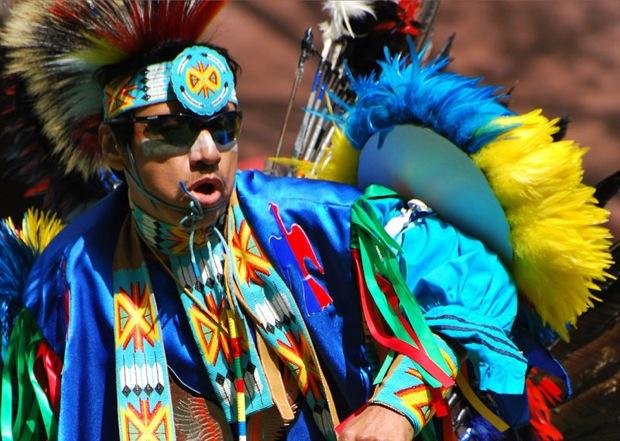
The American Indian Studies professor involved in the March 4 standoff with police was honored at CSUN’s 26th annual powwow.
Karren Baird-Olson, among others, was honored at the powwow by the Master of Ceremony Earl Neconie. The event held on Saturday, March 20 was filled with dances, songs and drums as friends and family gathered to share their American Indian culture.
“It’s hard to put into words,” Olson said about the honor. “It goes really deep. I don’t feel worthy, but it means everything.”
Olson and professor Scott Andrews, coordinator of the American Indian Studies Program, and Jasmine Navarro, president of the American Indian Association, led the honor song. They danced once around the circle, giving anyone who wanted an opportunity to shake their hands and follow them in the dance.
Others honored during the powwow were head woman dancer Lupe Lopez-Encalada, head young boy dancer Ashkii-Chee Kadenchii, head young girl dancer Starr Greensky, head man dancer Ben Wolf and Acton Powwow Princess Jennifer Jackson.
Another honoring song was the flag song, held during the grand entry.
“The flag song is honoring the first flags of these lands, honoring the eagle staffs, honoring those who carried those staffs, warriors and veterans,” Neconie said.
The elderly and veterans were also honored during the powwow.
An exhibition of the different dances included men’s northern traditional dancers, grass dancers, southern straight dancers and southern fancy shawl dancers and women’s jingle dress dancers, fancy shawl dancers and northern and southern dancers.
Kuno Funmaker, singer and drummer of the Ho Tanka drum circle, said he enjoyed the powwow because it gave them an opportunity to celebrate their culture.
“We get to be Indian again, to be who we are,” Funmaker said. “This is part of who I am, my culture. Anytime I get a chance to practice my culture, I do.”
The powwow began with a ground blessings and the grand entry of all participants led by Ernie Garcia WhiteCloud and all the head dancers.
“This is not a show,” said dancer Michael LittleVoice. “The circle is about healing, prayer and sacrifice.”
There is a song for each occasion in the powwow world, WhiteCloud said. The dances all mean the same thing, but each one has a different interpretation.
All modern powwow dance styles can be traced to the warrior society of the Plains tribes, according to the history of dancer, LittleVoice said. The purpose was almost always to help the people of the tribe.
Intertribal dances as well as the Oklahoma-style round dance and the Oklahoma-style two-step are social dances, where anyone who wanted to dance was encouraged to join in.
The drummers and singers were alternated between three drum circles throughout most the day: Northern, Southern, and Ho Tanka.
“The core of a powwow is the drum, the songs, and the dancing,” Funmaker said. “They say the drum is the heartbeat of the people and the earth.”
The names of the drum circles come from the territory it originated from, WhiteCloud said. In reality, the drum circle someone participates in is one of their own preference. The drummer can choose to be in the northern or southern drum circle by what they like to sing and drum to.
“I feel connected to everything when I drum,” Funmaker said. “In the city it’s easy to get off track spiritually. It’s kind of like my therapy, my medicine- spiritual medicine.”
“They say if you come close to the drums and the songs, you can get healed by it,” Funmaker said. “A lot of the dances are healing.”




